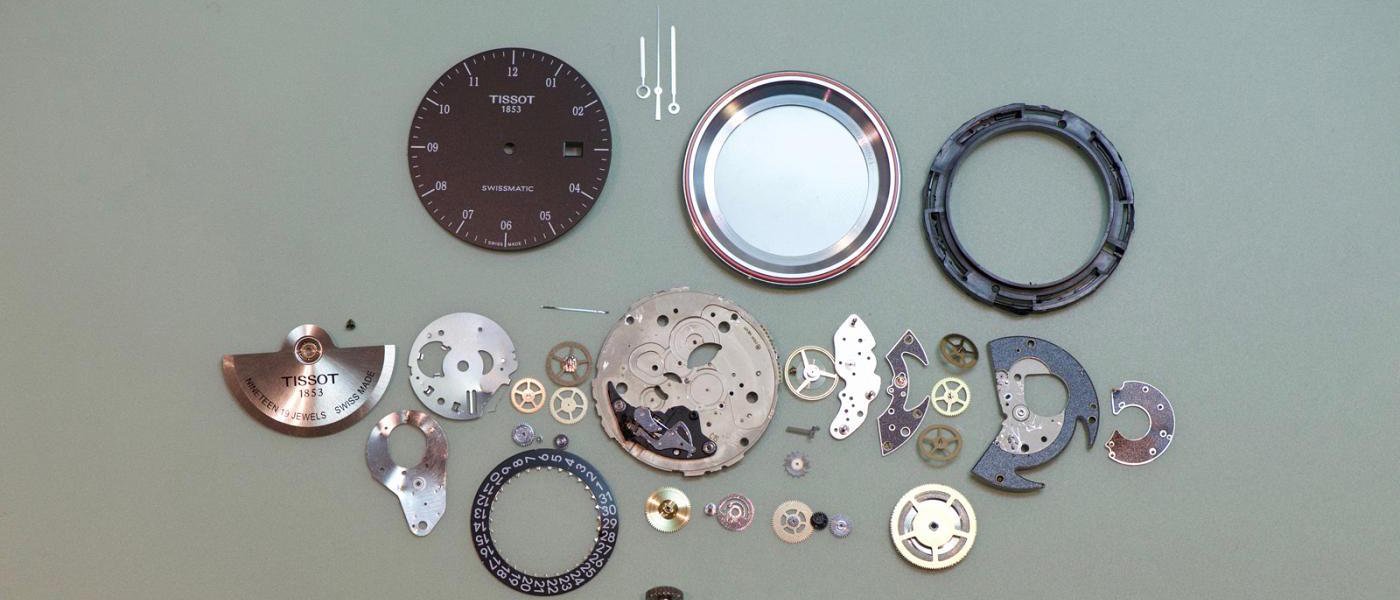e have oral confirmation of the figures: Tissot manufactures more than four million watches a year, all Swiss-made, half of which at least are fitted with mechanical movements. Given the prices that the Le Locle-based brand has always practised, this confirms its vocation to democratise Swiss watchmaking. And this vocation is about to gain momentum with the introduction of a self-winding, value-for-money movement already used by Swatch and manufactured in Switzerland – the Swissmatic.
Thanks to it, the brand is able to offer one heck of a bargain. A watch in the EveryTime range, equipped with a Swissmatic calibre, a 316L steel case, a sapphire crystal cover, a mineral glass back and a black watchstrap, will sell for just under 400 francs. In a subsequent phase, the movement will be incorporated into other ranges, most likely sports watches.
-

- Tissot Everytime Swissmatic with a rose gold PVD coating – the dressiest.
Industrial intelligence
Despite these ambitions, the Swissmatic cuts no corners. Self-winding, with the date, capable of a precision varying from -7 to +7 seconds a day and a power reserve up to 3 days, it performs much better than its direct rivals produced by the Japanese brands Miyota (a subsidiary of Citizen) and Seiko. This is typical of Tissot, which already offers the lowprice, self-winding Powermatic 80 movement, with a power reserve of 80 hours.
Tissot achieves all of this because it is a part of that powerful industrial manufacturing system, the Swatch Group. “Tissot is lucky enough to belong to the Swatch Group. That gives us special access to ETA and the industrial modernisation tool that was created for the Swatch,” says François Thiébaud, president of Tissot Watches. As a matter of fact the Swissmatic is a slight evolution of the movement that was much talked about at the presentation of the Swatch Sistem51: the ETA C10.111.
Industrial design
Like the ETA C10.111, the Swissmatic is assembled in an ETA factory in Boncourt in the Jura, in a semi-clean room, on a fully automated production line; it is soldered and riveted and comprises one single screw, and its regulating organ has no regulator, but is adjusted by laser, which modifies the behaviour of the balance to attain standard chronometric results. Also like the ETA C10.111, it is made mainly of ARCAP, a highly machinable alloy of copper, zinc and nickel, and plastic.
Tissot already deploys several ETA calibres that incorporate critical moving parts in synthetic materials, from the lever to the escape wheel and bridges. This initiative was first launched by the Le Locle behemoth back in the 1970s, with the launch of its all-plastic watches – at that time the material of the future – called Idea 2001 and Astrolon.
But the Swissmatic also differs from its counterpart. Its oscillating weight is in metal, with sunray brushing, and engraved. Its heavier weight allows it to be smaller in size. The date disc is not made of plastic, and its barrel is semi-open. Lastly, its flat surfaces are a sober black, just the opposite of the interplay of colours typical of Swatch. “The movement will be traditional in appearance. Adding colour isn’t part of our DNA,” explains François Thiébaud. There will be no confusing the backs of a Tissot and a Sistem51.
Industrial strength
Adoption of this new baby is important both for Tissot and for the watchmaking industry. For Tissot, it is a means of opening up a new front on the low-price mechanical watch market without nibbling away at quality and while still flying the Swiss-made flag. The high price of Swiss-made products is due largely to labour costs, a factor offset here by automation. For the watchmaking industry in general, the advent of this movement in a brand other than Swatch, one that is not known for throwaway watches, proves that the Swatch Group’s new, industrial-scale production methods are successful. And growing stronger. Because the assembly line set up in Boncourt is now capable of satisfying two players of large appetite, with needs that add up to several hundred thousand items a year.
With these volumes and these prices, the end product has to be perfect. Fitting Swatches with a mechanical calibre, however sophisticated and advanced it may be, is one thing: a Swatch Sistem51 cannot be opened and consequently cannot be repaired, as Europa Star demonstrated in its article ‘Stripping down the Sistem51’. It has to be exchanged. Incorporating it into a brand that is known for longevity is a different matter altogether. A Tissot watch is constructed in the conventional way. It has to allow easy access to its internal organs without leaving a scar. “Watches with a Swissmatic reflect Swiss expertise. They will always be repairable,” confirms François Thiébaud.

Industrial volumes
On the other hand, here is proof – if proof were needed – that Swiss watchmaking is not only traditional; that the methods used for making quartz calibres can be transposed to mechanical movements; and that there is an alternative to manual adjustment. In short, that the vision Swiss watchmaking has of itself, of perpetuated tradition, mountain landscapes and skilled jobs, is the stuff of picture postcards. Even that stronghold of quality and image, the mechanical movement, has entered into what the Swatch Group calls Industry 4.0.
This is opening up a whole new perspective for watches, one which is already omnipresent in other sectors, such as the automotive industry. “The car I bought last year was 30% cheaper than the equivalent one I bought ten years ago. It’s more powerful and better equipped. The automotive industry uses shared, modular platforms. That raises quality, performance and autonomy, and lowers prices, just like at Tissot,” concludes François Thiébaud. At the same time, the brand is planning a large-scale, international launch in line with its ambitions for this movement. Because the Tissot edifice is built on volume, volume and more volume.
What is inside the Tissot Swissmatic?
we dissected it. See here!
























































